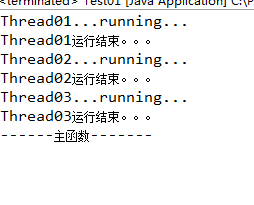JDK中解释为 Waits for this thread to die. 等待本线程结束后,下一个线程才可以运行。
实例要求:
现在有T1、T2、T3三个线程,你怎样保证T2在T1执行完后执行,T3在T2执行完后执行
实现代码:
package com.st.lesson02; public class Test01 { //1.现在有T1、T2、T3三个线程,你怎样保证T2在T1执行完后执行,T3在T2执行完后执行 public static void main(String[] args) throws InterruptedException { Thread th1 = new Thread01(); Thread th2 = new Thread02(); Thread th3 = new Thread03(); th1.start(); th1.join(); System.out.println("Thread01运行结束。。。"); th2.start(); th2.join(); System.out.println("Thread02运行结束。。。"); th3.start(); th3.join(); System.out.println("Thread03运行结束。。。"); System.out.println("------主函数-------"); } } class Thread01 extends Thread{ public void run() { System.out.println("Thread01...running..."); try { Thread.sleep(2000); } catch (InterruptedException e) { e.printStackTrace(); } } } class Thread02 extends Thread{ public void run() { System.out.println("Thread02...running..."); try { Thread.sleep(500); } catch (InterruptedException e) { e.printStackTrace(); } } } class Thread03 extends Thread{ public void run() { System.out.println("Thread03...running..."); try { Thread.sleep(1000); } catch (InterruptedException e) { e.printStackTrace(); } } }
运行效果图:
